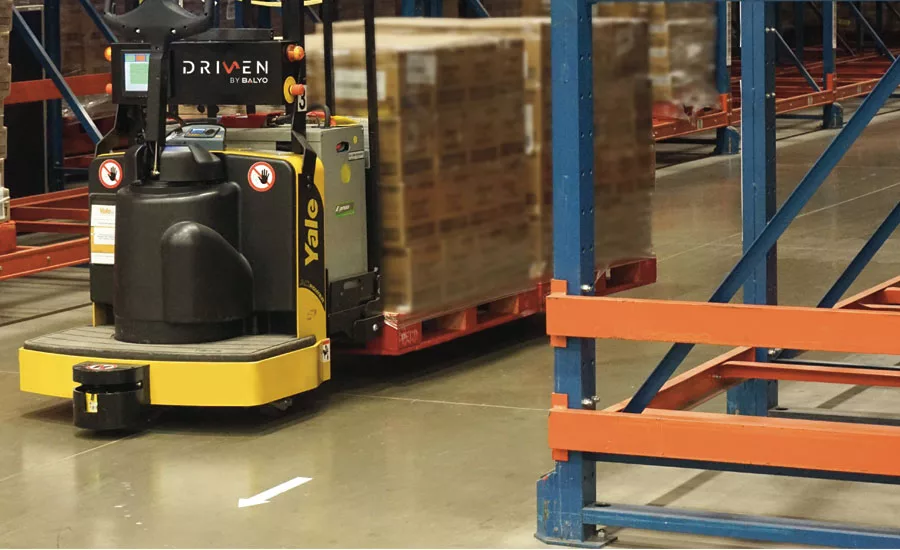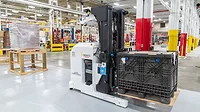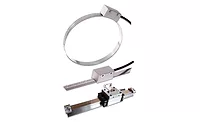Beverage plants boost productivity with automated guided vehicles
AGVs improve bottom line costs

Guided vehicles commonly share the warehouse fl oor with human counterparts, managing and overseeing the route and productivity of simple tasks. (Image courtesy of Yale Materials Handling Corp.)
Beverage production and warehousing goals to innovate, reduce overhead costs and improve productivity with a limited workforce are driving recent trends and advances in robotics and software. The use of automated guided vehicles (AGVs), or robotic lift trucks, is expanding as the industry finds ways to transition simple, repeatable tasks to guided or autonomous vehicles, experts say.
Between common load types, regularity of scheduling and activities such as picking up, transporting and positioning pallets, beverage companies are prime candidates for AGVs. Not only do the automated vehicles improve bottom-line costs, they are integral to improving beverage operations while boosting production.
“For example, trailer loading applications have dramatically increased during the past five years,” says Laura McConney, marketing specialist for AGVs at Chalfont, Pa-based JBT. She also believes companies are increasingly open to driverless options.
Previously driving automation — and reducing the number of people managing on the floor — may have been barriers for companies considering warehouse automation. Unlike automated vehicles on the highway, however, stringent warehouse safety standards reduce the possibility of accidents or pedestrian concerns. Policies with AGV providers also ensure safety is top of mind.
As a result, AGV and autonomous vehicle suppliers report spending less time educating and more time servicing customers who see value in productivity savings, reduced errors and accident–free bay help.
“The cost savings [of implementing guided vehicles] really helps people get over the unknown quickly,” McConney says. “Vehicles that follow installation and safety standards within our customer base are usually justified by these three drivers.”
Driving innovation
Technology in AGVs has the potential to advance faster in the beverage industry than any other industry, according to experts. Whether this is due to consistent delivery practices or technologically savvy workers in the warehouse, today’s equipment suppliers are offering automated solutions and innovating alongside their beverage partners.
“We expect [autonomous vehicles] to accelerate, as technology like artificial intelligence and machine learning advance, and current labor trends continue,” says Lou Micheletto, manager of integrated solutions for Yale Materials Handling Corp., Greenville, N.C. The advent of robotic lift trucks operating side-by-side with employees on plant floors is commonly referred to as “cobotics.”
In the beverage industry, AGVs might be in an onsite production warehouse and service area where they are performing automatic trailer loading and staging with a floor manager and over-the-road truck driver. It’s a common scenario given the consistency of shipping schedules and production processes that are perfect for vehicle automation and guided vehicle training.
In one example of two separate day-long tasks a JBT customer’s AGV performs, the finished product is moved between 12 stretch wrappers at the production lines, 15 truck bays, and 35 buffer storage lanes. The second task includes pickup of pallets of empty bottles from seven truck bays and delivery to six bottling lines.
“During trailer loading, sometimes there are not enough trailers available,” JBT’s McConney explains. “In that case, the AGV helps take loads to a staging area near the loading dock. This helps to avoid waiting for pallets, or waiting for product to come off the line, and product is ready to load [when the trailer arrives].”
During the staging process of block stacking pallets, SKUs can be tracked by the AGV software system to record what is being stored on the floor. In other cases, robotic lift trucks might be trained to entirely manage tasks solo.
“Standard lift trucks are outfitted with infrastructure-free navigation technology to allow them to function autonomously, moving and lifting/lowering — all without a human operator,” Yale’s Micheletto says. “Their deployment allows labor to be redeployed to more value-added roles, leaving robotic lift trucks to handle repetitive, low-value tasks like point-to-point load transportation.”
Eye on performance
The benefit of AGVs is not only the ability to perform many jobs on the warehouse floor — with or without a human — but also ease of adjustment. In the case of a floor layout change, map updates can quickly be made in AGV software. If manual operation is preferred because a machine is needed for an unexpected task, the operator can change settings and control the truck to move a pallet.
“Yale robotic lift trucks are designed with the dual ability of operating independently and being able to change to manual mode with the touch of a button in the event of an unplanned/unique requirement,” Micheletto says.
In the case of Yale trucks, built-in laser technology independently maps a route for the truck to follow.
“Yale robotic lift trucks contain a device at the top of the truck that uses LiDAR technology,” Micheletto explains. “This laser-based technology looks at walls, pillars, racking and other existing structural elements to provide data points for navigation. It builds an internal map by driving around a facility and then comparing its stored map to what it sees in real time.”
In addition to this navigation technology, JBT has been investing in 3-D technology for imaging to better track pallet activity.
“The advances in imaging more accurately scans fork pockets and pallet openings as well as racking to more easily pick pallets,” JBT’s McConney says. “This enables vehicles to be more agile within a warehouse and eliminate the pausing or intrinsic thinking time and verification process, in addition to steering clear of humans.”
The automation extends beyond the warehouse, however. In companies taking advantage of AGVs and advances in technology such as video diagnostics, the software package is a connected experience throughout the warehouse and between raw goods as well as the inventory management process.
JBT automated guided vehicles controlled by SGV Manager software can communicate with Warehouse Management System (WMS) software and plant programmable logic controllers (PLCs) to facilitate movement of empty bottles and finished goods.
But automation can start simply by identifying repeatable tasks and having a plan for expansion, which experts can help define.
“An operation can be implemented through a phased approach, with the initial phase being to simply get the robotic lift trucks moving around and executing load transportation tasks,” Yale’s Micheletto says. “Then, interfacing with the WMS can come as phase two. This enables easier initial adoption and can avoid potential IT roadblocks.” BI
Looking for a reprint of this article?
From high-res PDFs to custom plaques, order your copy today!





